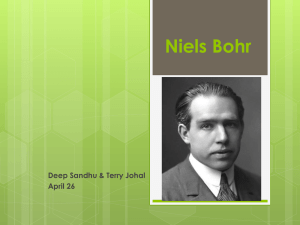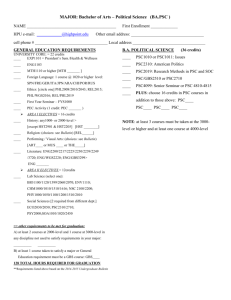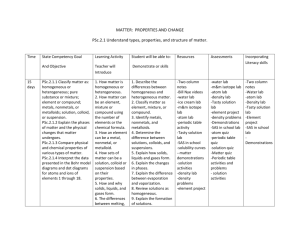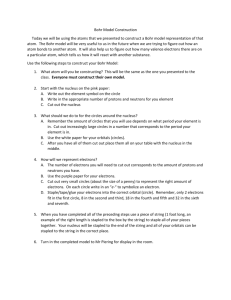first 6 weeks phys sci
advertisement
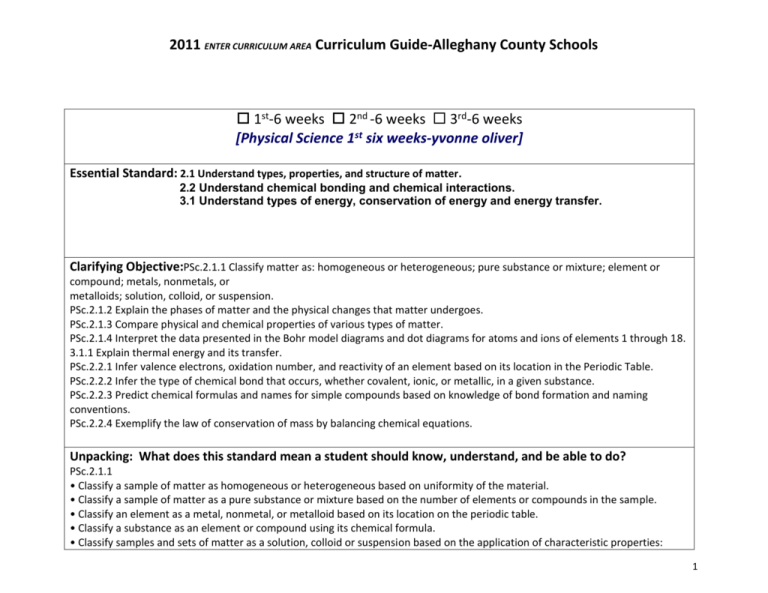
2011 ENTER CURRICULUM AREA Curriculum Guide-Alleghany County Schools 1st-6 weeks 2nd -6 weeks 3rd-6 weeks [Physical Science 1st six weeks-yvonne oliver] Essential Standard: 2.1 Understand types, properties, and structure of matter. 2.2 Understand chemical bonding and chemical interactions. 3.1 Understand types of energy, conservation of energy and energy transfer. Clarifying Objective:PSc.2.1.1 Classify matter as: homogeneous or heterogeneous; pure substance or mixture; element or compound; metals, nonmetals, or metalloids; solution, colloid, or suspension. PSc.2.1.2 Explain the phases of matter and the physical changes that matter undergoes. PSc.2.1.3 Compare physical and chemical properties of various types of matter. PSc.2.1.4 Interpret the data presented in the Bohr model diagrams and dot diagrams for atoms and ions of elements 1 through 18. 3.1.1 Explain thermal energy and its transfer. PSc.2.2.1 Infer valence electrons, oxidation number, and reactivity of an element based on its location in the Periodic Table. PSc.2.2.2 Infer the type of chemical bond that occurs, whether covalent, ionic, or metallic, in a given substance. PSc.2.2.3 Predict chemical formulas and names for simple compounds based on knowledge of bond formation and naming conventions. PSc.2.2.4 Exemplify the law of conservation of mass by balancing chemical equations. Unpacking: What does this standard mean a student should know, understand, and be able to do? PSc.2.1.1 • Classify a sample of matter as homogeneous or heterogeneous based on uniformity of the material. • Classify a sample of matter as a pure substance or mixture based on the number of elements or compounds in the sample. • Classify an element as a metal, nonmetal, or metalloid based on its location on the periodic table. • Classify a substance as an element or compound using its chemical formula. • Classify samples and sets of matter as a solution, colloid or suspension based on the application of characteristic properties: 1 2011 ENTER CURRICULUM AREA Curriculum Guide-Alleghany County Schools particle size, “settling out” of one or more components, and interaction with light (Tyndall Effect). PSc.2.1.2 • Develop a conceptual cause‐and‐effect model for the phase change process that shows the relationship among particle attraction, particle motion, and gain or loss of heat ‐ when a solid melts it has absorbed heat that increased the potential energy of its particles (space between particles) thus reducing the attraction between particles so that they can flow in a liquid phase. (Consider conditions of normal atmospheric pressure as well as the qualitative affects of changes in pressure involving gases.) • The focus should be on the following phase changes: solid to liquid (melting), liquid to gas (vaporization), gas to liquid (condensation), and liquid to solid (freezing). • Compare the process of evaporation to vaporization – materials that evaporate verses those which do not; attraction between surface particles and colliding air molecules. • Recognize that the formation of solutions is a physical change forming a homogenous mixture. (Review from 8th grade.) • Develop a conceptual model for the solution process with a cause and effect relationship involving forces of attraction between solute and solvent particles. A material is insoluble due to a lack of attraction between particles. • Interpret solubility curves to determine the amount of solute that can dissolve in a given amount of solvent (typically water) at a given temperature. • Qualitatively explain concentration of solutions as saturated, unsaturated or supersaturated; dilute or concentrated. PSc.2.1.3 • Calculate the density of different substances using the relationship. D=M/V • Compare physical properties of a mixture that could be used to separate its components such as solubility, density, boiling point, magnetic property, etc. • Compare various physical and chemical properties of metals, nonmetals and metalloids such as state of matter at a given temperature, 2 2011 ENTER CURRICULUM AREA Curriculum Guide-Alleghany County Schools density, melting point, boiling point, luster, conductivity, ductility, malleability, color, reactivity, etc. • Compare physical and chemical properties of various everyday materials such as salt, sugar, baking soda, corn starch, rubbing alcohol, water, etc. PSc.2.1.4 • Describe the charge, relative mass, and the location of protons, electrons, and neutrons within an atom. • Calculate the number of protons, neutrons, electrons, and mass number in neutral atoms and ions. • Explain how the different mass numbers of isotopes contributes to the average atomic mass for a given element (conceptual, no calculations). • Use isotopic notation to write symbols for various isotopes (ex. Carbon‐12, C‐12, 12C, etc.) • Explain Bohr’s model of the atom. • Draw Bohr models from hydrogen to argon including common isotopes and ions. • Construct dot diagrams, a shorthand notation for Bohr models, using the element symbol and dots to represent electrons in the outermost energy level. PSc.3.1.1 • Infer the ability of various materials to absorb or release thermal energy in order to conceptually relate mass, specific heat capacity, and temperature of materials to the amount of heat transferred. (Calculations with Q=mCp ΔT should be used to aid in conceptual development through laboratory investigation and analysis, not as problem‐solving exercises.) • Compare thermal energy, heat, and temperature. • Relate phase changes to latent heat that changes the potential energy of particles while the average kinetic energy of particles (temperature) remains the same. (Link to PSc.2.1.2) • Compare conduction, convection, and radiation as methods of energy transfer. Essential Vocabulary: Homogeneous, heterogeneous, pure substance, mixture, element, compound, solution, colloid, suspension, Tyndall Effect, heat, freezing, melting, vaporization, condensation, evaporation, solvent, solute, insoluble, solubility curves, concentration, saturated, unsaturated, supersaturated, dilute, concentrated, density, metals, nonmetals, metalloids, luster, conductivity, ductility, malleability, reactivity, physical 3 2011 ENTER CURRICULUM AREA Curriculum Guide-Alleghany County Schools property, chemical property, charge, relative mass, proton, neutron, electron, atomic number, average atomic mass, neutral atom, ion, isotope, isotopic notation, Bohr model, Lewis‐dot diagram, energy levels, valence electrons. thermal energy, specific heat capacity, heat, temperature, latent heat, conduction, convection, radiation, Learning Targets: “I Can” I can investigate and classify different samples of matter. I can examine the periodic table to classify matter I can model the phase change process and the Identify Student Success: "I Will" ‐ I will examine a sample of matter and determine whether it is homogenous or heterogeneous. ‐ I will examine a sample of matter and determine whether it is pure substance or a mixture. ‐ I will examine a sample of matter and determine whether it’s a solution, colloid, or suspension. ‐ I will identify the characteristics of a solution, colloid, or suspension effect by particle size, “settling out”” of one or more component or interaction of light (Tyndall Effect) I will identify where metals, nonmetals, and metalloids are located on the periodic table. ‐ I can look at a chemical formula and identify whether it is an element or a compound. I will illustrate or demonstrate the different relationships of particle 4 2011 ENTER CURRICULUM AREA Curriculum Guide-Alleghany County Schools relationship among the particles of matter. attraction in solids. Liquid, and gases ‐ I will illustrate or demonstrate the different relationships of particle motion in solids. Liquid, and gases ‐ I will illustrate or demonstrate the different relationships of gain or loss of heat in solids. Liquid, and gases ‐ I will investigate how pressure affects the movement of particles in a gas. I can identify various phase changes I will illustrate melting, freezing, vaporization, and condensation. ‐ I will interpret a phase change diagram or graph I can compare evaporation and vaporization I will explain the difference between evaporation and vaporization ‐ I will explain why some substances do not evaporate ‐ I will explain relationship between surface particle attraction and colliding air molecules. I can identify the formation of a homogenous mixture as Solution I will explain why solutions are classifies as homogenous mixtures ‐ I will explain why a formation of a solution is a physical change I can explain the parts of a solution and determine the I will identify the solute and solvent of a solution 5 2011 ENTER CURRICULUM AREA Curriculum Guide-Alleghany County Schools solubility. ‐ I will analyze the cause and effect relationship involving the forces of attraction between a solute and solvent. I can analyze and interpret a solubility graph. I will use a solubility graph to determine the concentration of a solution (saturated, unsaturated, supersaturated I can analyze and explain the concentrations of a solution. I will identify if a solution is dilute or concentrated and classify the solution as saturated, unsaturated, or supersaturated. I can investigate how to mathematically calculate the density of different substances. I will perform an inquiry lab to determine the density of unknown objects. ‐ I will calculate density using D=m/v ‐ I will compare the relationship between the mass, volume, and density of different objects. I will analyze and interpret density graphs. I can investigate the physical properties of mixtures I will identify through investigation components of a mixture including solubility, density, boiling point, magnetic property, etc I can compare the physical and chemical properties of the I will identify the various physical and chemical properties of 6 2011 ENTER CURRICULUM AREA Curriculum Guide-Alleghany County Schools elements of the periodic table metals, nonmetals, and metalloids. ‐ I will identify them by state of matter at a given temperature, density, melting point, boiling point, luster, conductivity, ductility, malleability, color, reactivity, etc. I can investigate the physical and chemical properties of common everyday materials. I will perform a lab activity in which I classify everyday materials such as salt, sugar, baking soda, corn starch, rubbing alcohol, water, etc I can identify the parts of an atom. I will illustrate the location of protons, electrons, and neutrons. ‐ I will determine the charge and relative mass of protons, electrons, and neutrons. I can mathematically determine protons, electrons, and neutrons, and mass numbers of atoms and ions. I will calculate the number of protons, electrons, neutrons, and mass for a given atom or ion. I can analyze the existence of isotopes. I will relate isotopes and average atomic mass in conceptual circumstances, (such as comparisons to grades and grade averages). I will identify and write symbols and isotopic notations for various isotopes, (Carbon‐12, C‐12, 12C. etc.). 7 2011 ENTER CURRICULUM AREA Curriculum Guide-Alleghany County Schools I can identify and analyze a Bohr model. I will explain the parts of a Bohr model. ‐ I will identify number of electrons on each energy level. ‐ I will interpret various Bohr models of elements I can design Bohr models of elements 1 to 18 on the periodic table I will illustrate Bohr models from Hydrogen to Argon. I will illustrate Bohr models of common isotopes and ions. I can create and model Lewis‐dot diagrams. I will illustrate dot diagrams of Bohr models, using symbols and dots to identify valence electrons located in the outermost energy levels I can predict valence electrons on the Periodic Table. I will identify valence electrons, based on their location in Groups 1, 2, and 13‐18. I will illustrate valence electrons with Lewis‐dot diagrams. I can predict an element’s oxidation number. I will identify oxidation numbers, based on their location in Groups 1, 2, and 13‐18, including the elements tin and lead (transition metals). I can generalize periodic trends. I will compare reactivity of metals and nonmetals I can analyze and predict the different types of chemical bonds. I will compare and contrast ionic, covalent, and metallic bonding. I will illustrate different types of bonds using Lewis‐dot diagrams. 8 2011 ENTER CURRICULUM AREA Curriculum Guide-Alleghany County Schools I can name and write formulas for simple ionic binary compounds. I will demonstrate how to name formulas for elements found in Group 1, 2, and 3‐18. I can name and write formulas for simple compounds containing polyatomic ions. I will demonstrate how to name formulas for elements containing polyatomic ions found in Group 1,2, and 3‐18 I can name and write formulas for covalent binary Compounds I will demonstrate how to name formulas for elements containing polyatomic ions found in Group 1,2, and 3‐18 I will apply Greek prefixes ( mono, di, tri, tetra, etc), to properly name covalent compounds I can demonstrate how to balance chemical equations. I will demonstrate the ability to count elements in a given formula. ‐ I will manipulate coefficients to demonstrate the Law of the Conservation of Matter. I can explain how various materials absorb or release thermal energy I will interpret graphs to infer how mass, specific heat capacity, and temperatures are related. ‐ I will analyze through investigation how heat is transferred through various materials. ‐ I will compare and contrast thermal energy, heat, and temperature. 9 2011 ENTER CURRICULUM AREA Curriculum Guide-Alleghany County Schools I can relate phase changes to changes in energy. I will explain how potential energy and kinetic energy are related to the phases of matter. ‐ I will demonstrate and graphically illustrate that there is not a phase change during latent heat period. I can explain methods of energy transfer I will explain and diagram real world examples of conduction, convection, and radiation. I can demonstrate the law of conservation of energy I will demonstrate how kinetic energy, potential energy, and heat are related through an investigation on mechanical systems (ex: pendulum, roller coaster, cars/balls on ramps, etc) I will explain how friction in a system is transformed from mechanical energy to heat energy. Resources: Textbooks, relevant internet activities, labs and simulations, videos, DVD’s, CD-ROMS Extensions (for students who achieve the goals initially): Advanced internet activities, labs and simulations that are relevant 10 2011 ENTER CURRICULUM AREA Curriculum Guide-Alleghany County Schools Reteaching strategies/intervention plans (for students who do not achieve the goals initially): Attend Wednesday afternoon (1 hour) sessions for extra help, as well as Friday sessions if necessary. 11
